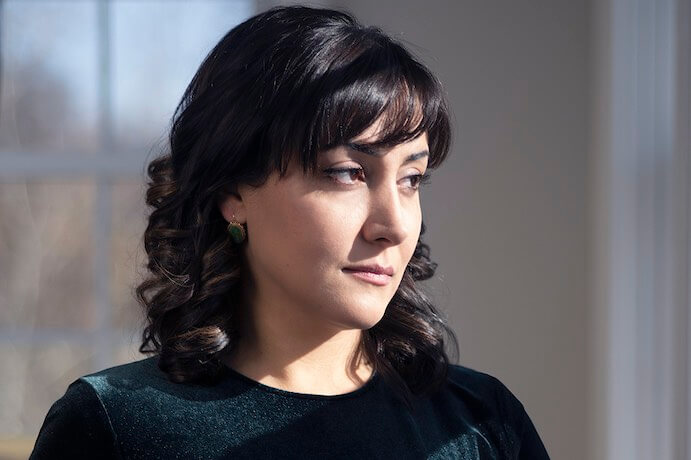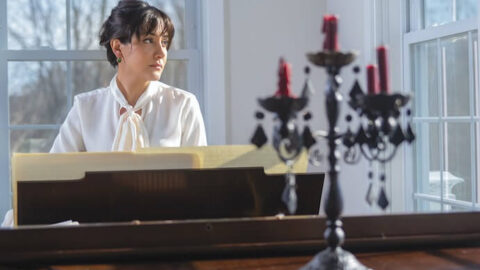If you’ve heard music by composer Gity Razaz, you know its power. Gity’s wide, sweeping sonorities are made of those especially vivid in-between colors, and her textures span the spectrum from dry, sharp staccatos to translucent washes of harmonics and overtones, all restlessly undulating from one moment to the next. Exquisite examples of her writing for strings can be heard on her solo album The Strange Highway (BIS Records, 2022), and several new pieces have been added to her catalog this season.
Her delightful traipses through time and texture are sure to be heard in the upcoming Canadian premiere of her orchestral work, Methuselah (In Chains of Time), by the National Arts Centre Orchestra in February. Originally commissioned for the San Diego Symphony as part of the League of American Orchestras’ Virginia B. Toulmin Orchestral Commissioning Program, the work is inspired by a nearly 5,000 year old tree hidden in the White Mountains of Inyo County in eastern California — it is such a precious living relic that its location is kept secret! Different eras also collide in Gity’s solo cello work for Alisa Weilerstein, which can be heard in April at the Kennedy Center. The piece was written for Alisa’s “Fragments” project, where newly composed works are interspersed with movements from Bach’s cello suites.
Born in Tehran, Iran, Gity’s work often centers her homeland’s stories, music, and culture, which will no doubt play a role in her curation of “The Wonders We Carry Inside,” a chamber music concert performed by musicians from the San Diego Symphony that honors women and Persian culture. The existential musings of Rilke and Rumi — their similarities, their differences — are also being explored by Gity this season in a new song cycle called Flowing Down the Widening River, which will be premiered by the Israeli Chamber Project in April.
You’ve already written several solo string instrument works. In your new piece for Alisa Weilerstein’s Fragments project, what influence, if any, did Bach have on this commission that makes the work distinct from the other string pieces in your catalog?
I was thrilled when Alisa contacted me to be a part of this exciting, ground-breaking program that features works of 20+ contemporary composers, blended seamlessly in concert with movements from the Bach cello suites. She had heard my previous works for solo cello, particularly Legend of Sigh. She expressed that the reason behind commissioning many composers (from vastly different sound worlds) was to have a broad and all-encompassing musical language. So the connection to Bach was essentially just a point of departure for me, and I decided to write my two pieces — Secrets, Invocations — in my natural musical language, while still honoring and responding to the sound world of Bach’s masterpieces.
Can you take us through your research process, especially with works like Methuselah where you are restricted in your physical access to the subject matter?
I first came across a picture of the nearly 5,000 year-old tree in a Buddhist magazine, and I was immediately struck by the awe-inspiring shape of the trunk, braided around its core and twisting upwards from the bone-dry surface of the rock-covered ground. There is hardly any surrounding vegetation, and the extreme climate — Methuselah is located around 10,000 feet above sea level — makes the tree’s longevity a true rarity.
Without physical access to the tree itself, my imagination was free to roam more broadly and freely in the mystery and mystique surrounding this phenomenon of nature. I immersed myself in the many articles, interviews, and documentaries made about the life, timeline, and scientific discoveries about longevity of the Methuselah tree. Although the actual shape of the tree is the main focus and inspiration for the form and structure of my piece, these disparate findings did inform many characteristics of the musical materials and sonic gestures in the piece.

What is the most striking similarity between Rumi and Rilke’s writings that you came across when working on your new song cycle? How did you divide Rumi and Rilke’s presence in the piece?
Rumi and Rilke lived about 700 years apart and on nearly opposite sides of the earth, and with completely different religious backgrounds. Yet their philosophical and imaginative perspectives on some of the most existential topics in the history of mankind are eerily similar. In the poems selected for this project, I was attracted to the almost identical poetic imagery they both used of “widening rings and circles” to describe life and existence. Rumi calls for embracing uncertainty and living the “questions,” “flowing down the always widening rings of being,” while Rilke acknowledges life’s unyielding truth, and moves through it with the confession that “I live my life in widening circles…”
One of the most apparent differences between the two poets (essentially both mystics) is felt in how they expressed their beliefs. Rilke is an introspective poet; his writings display the depth of his quest, but also a gentle, relatable vulnerability. Rumi is almost the other extreme altogether, as he writes from a place of ecstasy and unearthly exultation, as if in the midst of an out-of-body experience. Sometimes in the attempt to translate his poems’ euphoria, however, we lose sight of the subtlety and nuance of the original language. In their own ways, both Rilke and Rumi’s poems therefore allow great opportunities for musical settings.
There is also some selected text from Emerson’s essay Circles, which provides a beautiful continuity of thematic material through exceptionally similar sentiments to that of Rilke and Rumi.

Balancing composing hours with all the other demands in one’s day can often prove frustratingly difficult! What is one piece of advice you would give to composers and creatives about their workflow and how they allocate time during the day to their art?
Be honest about the number of hours you can actually be productive compositionally each day, and then surround those hours with activities that provide creative energy. If I try to spend an entire day wringing music from every minute, I end up producing music that is dry and forced. If, on the other hand, I let my imagination rest and gather resources — through listening to music I admire, challenging my ears with new pieces, playing the piano, reading through scores, looking at art that might inspire, or even going on walks to take in the grandeur of the world around me — I end up finding a rhythm more quickly and naturally, even if my time spent composing amounts to fewer hours. There are times where you will have to struggle throughout the day to find a solution to a compositional problem, but for the generation of new ideas, there is a necessary dance between the act of creation and that of replenishment.
[Tweet “For the generation of new ideas, there is a necessary dance between the act of creation and that of replenishment.”]
Like crop rotation, sometimes having a non-music creative outlet can actually be helpful. Do you have any hobbies or other interests that also use your creativity?
Painting has provided the most fruitful counterpoint to composition, simply for the fact that its purpose is the act itself. There is no judgment, no fine-tuning nor revisions, no facet of its existence beyond what is put down on paper. It can be as free, tangible, and uninhibited as composition can be structured, mystical, and imposing. When I’m writing, there is often an intellectual struggle to wrest notes from the fleeting intangibility of what I hear in my head, whereas when I paint, I can produce instantly without reserve and without impediment. For me, because I embrace this free-form, spontaneous way of painting, there is a joy to the act that can’t be replicated in composing, but provides a necessary, complementary break such that I can come back to writing refreshed and with renewed purpose.
I CARE IF YOU LISTEN is an editorially-independent program of the American Composers Forum, funded with generous donor and institutional support. Opinions expressed are solely those of the author and may not represent the views of ICIYL or ACF.
A gift to ACF helps support the work of ICIYL. For more on ACF, visit the “At ACF” section or composersforum.org.
























